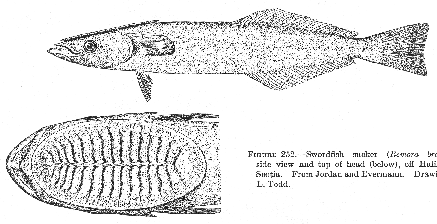Swordfish sucker Remora brachyptera (Lowe) 1839 [24]
[Jordan and Evermann, 1896-1900, p. 2272]

Figure 252.—Swordfish sucker (Remora brachyptera), side view and top of head (below), off Halifax, Nova Scotia. From Jordan and Evermann. Drawings by H. L. Todd.
Description—
This is a stouter fish than the shark sucker (p. 485), being only about seven times as long as it is deep (counting the caudal fin) and about as thick through the shoulders as it is deep, with a thicker caudal peduncle. And although the sucking plate is as long, relatively, it consists of only 14 to 17 ridges. Furthermore, the pectoral fins of the swordfish sucker are relatively shorter than those of the shark sucker, softer, and rounded instead of pointed, while the upper margins of these fins are not so close to the edge of the sucking plate. The ventral fins, too, are attached to the skin of the abdomen along their inner margins for at least one-half their length, as noted above (p. 485). The long dorsal fin (29 to 32 rays) of the swordfish sucker serves to separate it from the remora (p. 487).
Color—
Described as light reddish brown above and as darker below, with paler dorsal and anal fins. A distinctive feature is that it lacks the side stripes and white fin edgings so characteristic of the shark sucker.
Size—
A length of 12 inches is the maximum so far recorded.
General range—
Warm and warm-temperate seas generally, probably paralleling that of the swordfish.
Occurrence in the Gulf of Maine—
Goode and Bean's[25] description of this sucker as not infrequently accompanying swordfish into Massachusetts Bay probably applies to the whole Gulf except the Bay of Fundy, for specimens have been brought in from near Matinicus Rock and near the Isles of Shoals; fishermen occasionally speak of seeing "suckers" clinging to the swordfish they harpoon on the offshore Banks; sometimes several fastened to a single swordfish. But they also report far more swordfish lacking these uninvited guests than carrying them, and this has been the case with the few fish harpooned by the Grampus during our cruises in the Gulf. Suckers are described by eyewitnesses as usually fast to the shoulder of the swordfish, nor have we heard of one actually within the gill cover of the latter, though very likely they refuge there, for one has been [page 487] taken from the gill cavity of a sunfish (Mola mola); others have been found in the mouths and gill cavities of large sharks.
Nothing beyond this is known of its way of life. Presumably it feeds on fragments of the fish killed by its host, as the shark sucker does whose actions are better known. Presumably, too, it is an active a swimmer as are its relatives. Nothing is known of its breeding habits.